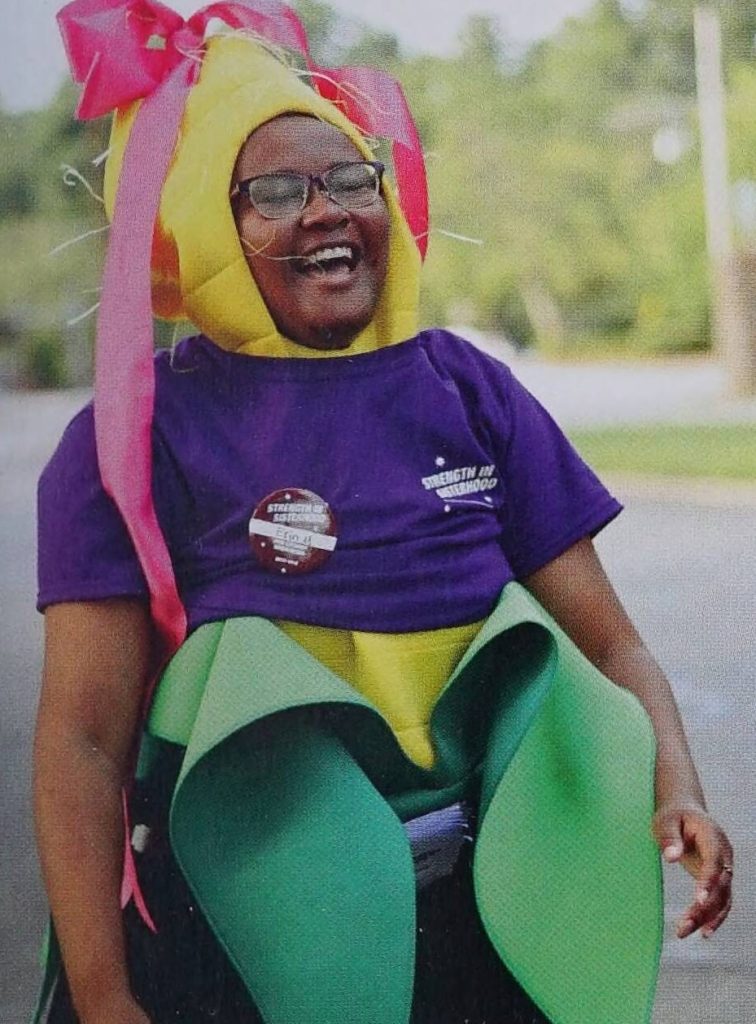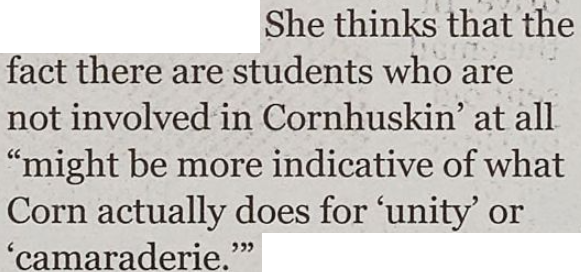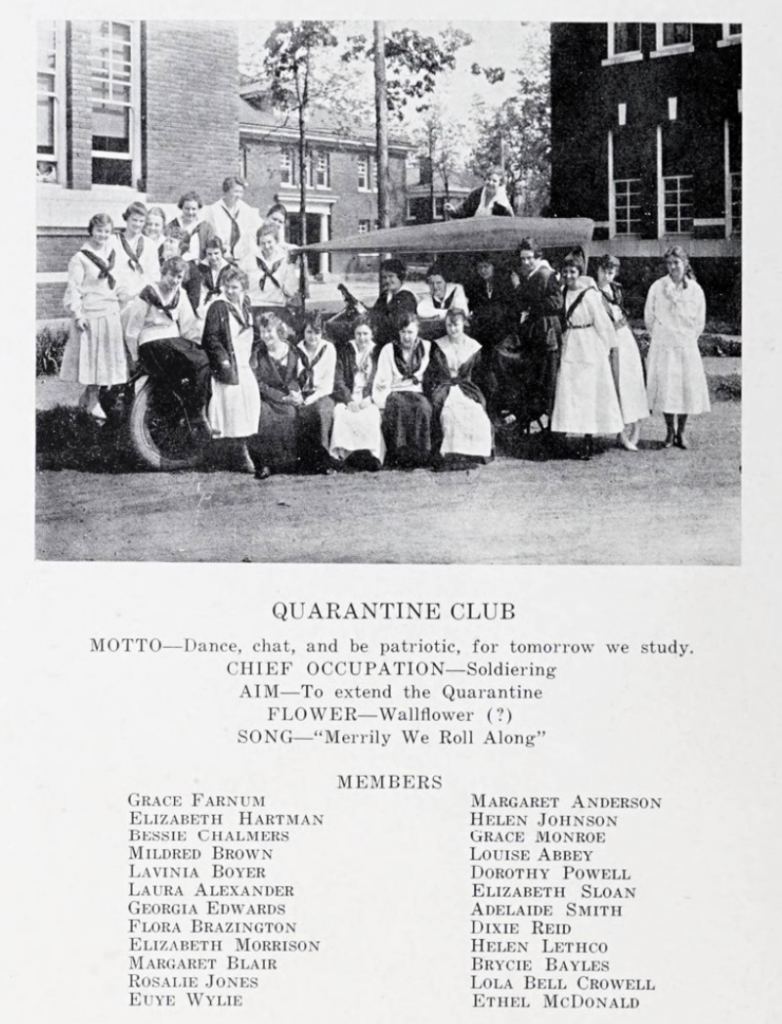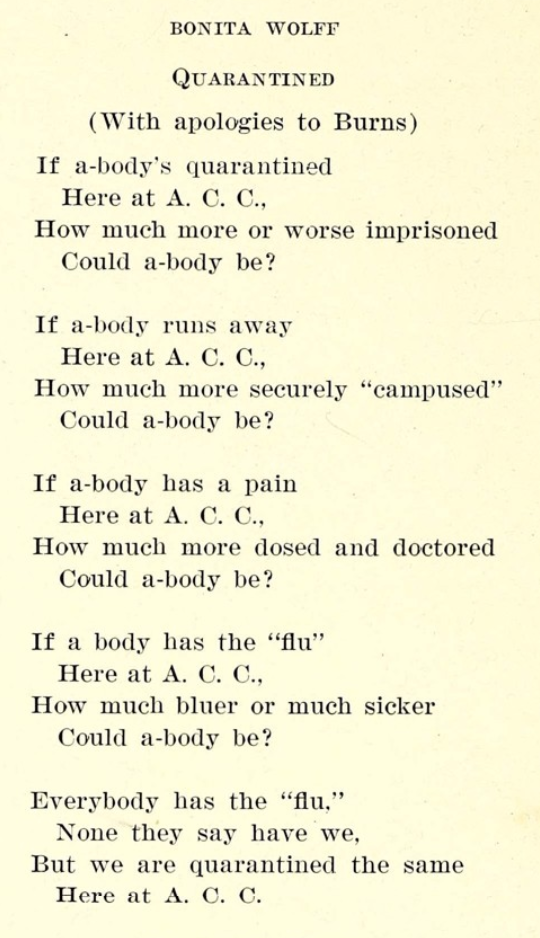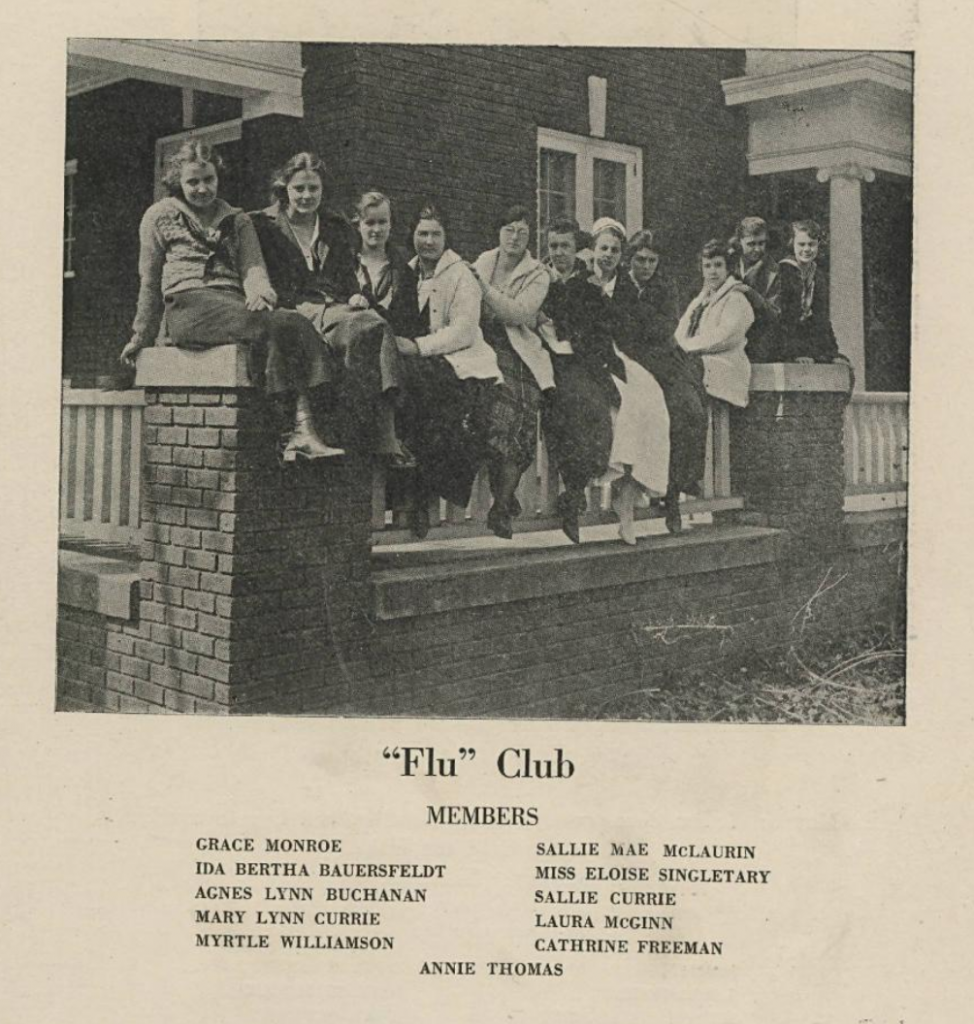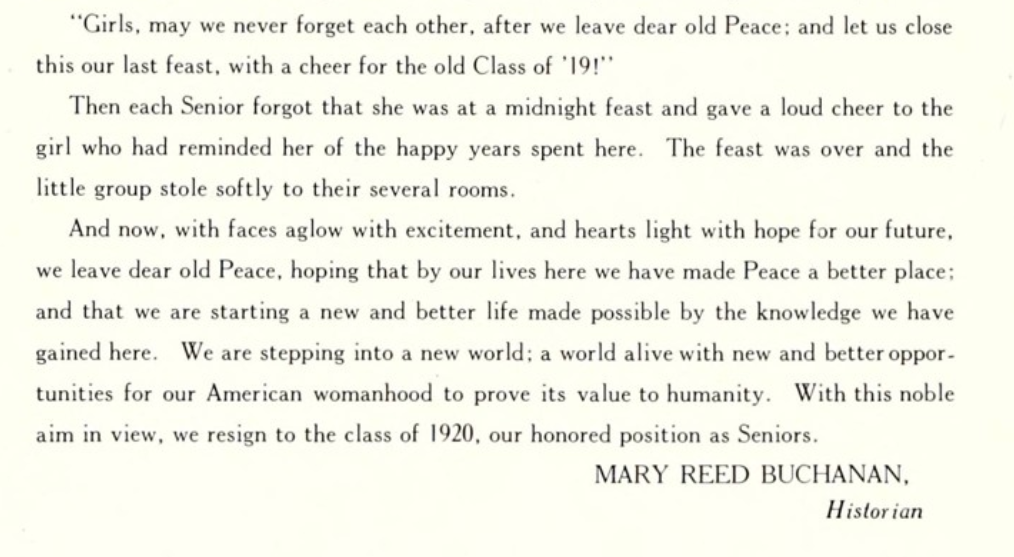Thanks to our partner, Meredith College, issues of the Meredith Herald from 2020 to 2023 along with four of the college’s most recent yearbooks are now available on DigitalNC!
The Cornhuskin’ tradition at Meredith College was introduced in 1945 by Doris Peterson, an associate professor raised in the Midwest, to honor the freshman class. Originally called a Husking-Bee Party, the events at first Cornhuskin’ included chicken-calling, hog-calling, and corn shuckin’. Over time the tradition has transformed and adapted to suit the themes and popular culture of the times, with new events, skits, songs, and timetable, but it has always been a way to showcase class spirit and bond classes together.
In recent years, however, that bond and class spirit appears to be diminishing. Articles in the November 11, 2021 issue of the Meredith Herald include discussions of how poor accessibility accommodations coupled with lack of camaraderie have made student attendance at Cornhuskin’ physically impossible and unappealing.
This and other current issues that Meredith students are discussing are now all available on DigitalNC!
To learn more about Meredith College, visit their website here.
To view more materials from Meredith College, visit their contributor page linked here.
For explore more yearbooks from across North Carolina, visit our North Carolina Yearbook collection.
To view more newspapers from across North Carolina, please view our North Carolina Newspapers collection linked here.
Thanks to our partner, Meredith College, we now have more editions of the Meredith College student newspapers the Meredith Herald and the Twig, and the yearbook, Oak Leaves.
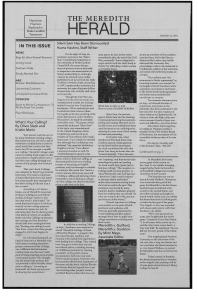
Front page of the September 12, 2018 issue of the Meredith Herald.
This batch includes issues of the Twig from April 10, 1965-May 25, 1966 and issues of the Meredith Herald from March 4, 2015-April 10, 2019. Both newspapers report on events both at the college and in the surrounding area. The issues of the Twig include topics such as drinking legislation updates and graduation schedule announcements. Issues of the Herald include topics such as the Silent Sam controversy at UNC-Chapel Hill and the name change for the Meredith College newspaper from the Twig to the Meredith Herald. Also recently uploaded are editions of Oak Leaves, the yearbook of Meredith College, from 2010-2018.
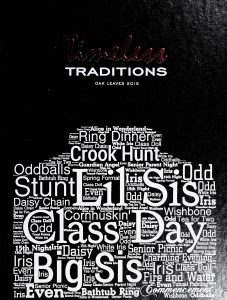
The cover of the 2015 edition of Oak Leaves, the yearbook of Meredith College.
To view all of the items we’ve scanned for Meredith take a look at their contributor page. For more information about this partner, visit their website.

More than 30 years of Meredith College Student Newspaper issues are now available on DigitalNC. With this addition, you can now browse the complete collection ranging from 1921 to 2015. These newspapers could be resources for anyone interested in student life at women’s colleges and the changes that take place over several decades.
Check out all of the recently added issues at the links below:
To see more from items from Meredith College, visit their contributor page or the website.
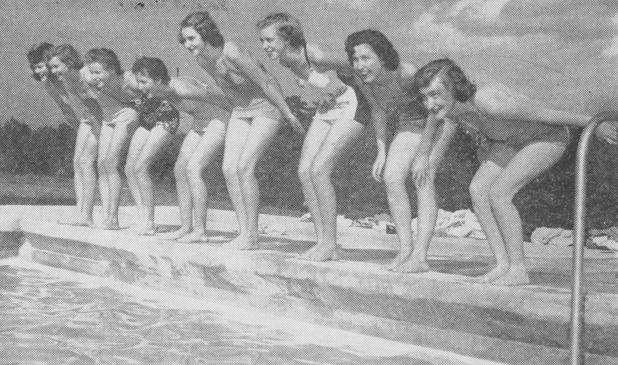
From the April 22, 1950 issue of the Twig
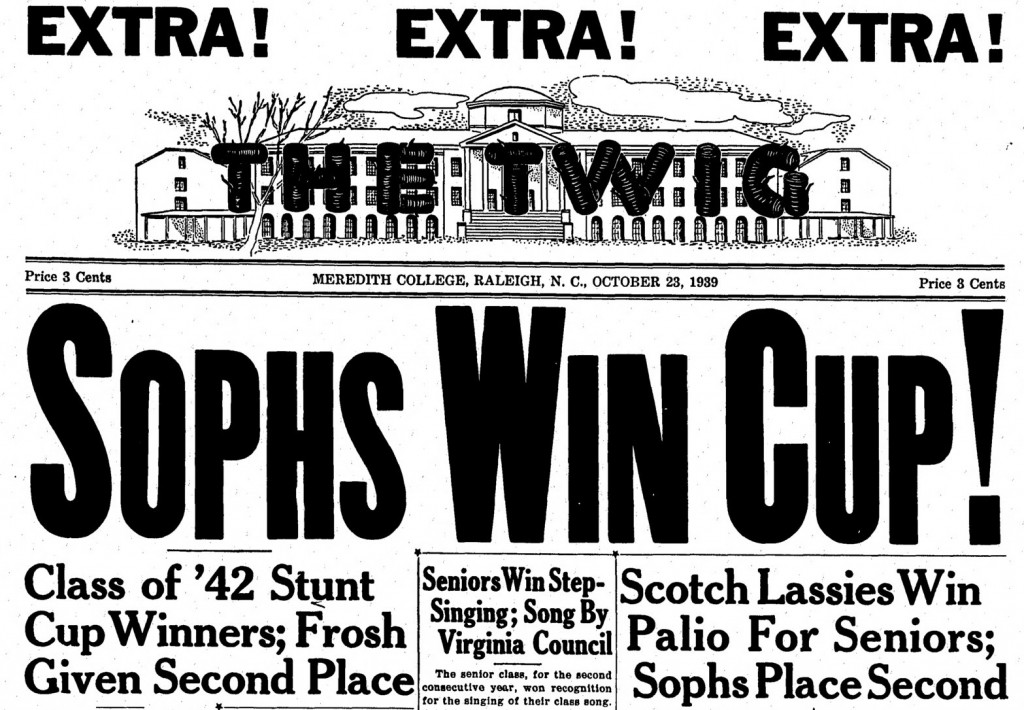
Headline from the October 23, 1939 issue of The Twig
Issues of Meredith College’s student newspaper from 1921-2009 have been added to DigitalNC. This is just in time for Meredith’s 125th anniversary, which the college is celebrating over the 2015-2016 school year.
Meredith is a women’s college located in Raleigh, with a student body of around 2,000. The school’s student newspaper began in April 1921 as The Twig. In January 1986, the paper changed to the Meredith Herald, its current title, in an effort to remake it to “more professional reporting and looking paper.”
“Stunt,” “Palio,” “Corn huskin'” – as we were processing this newspaper we kept coming across the strangest terms making big headlines. It turns out that longstanding traditions with names like these are a hallmark of Meredith College, and it’s interesting to see how many started in the school’s earliest days. “Stunt” has been ongoing since 1915, and mention is made in the October 1921 issue of the paper. The first Palio, which eventually became “Corn Huskin'” can be found on the “Stuntsville Starter” page of The Twig, September 28, 1935. The page below, from October 27, 1934, shows that Stunt Day activities included Tree Planting, Bicycle Racing and, of course, the Stunts.
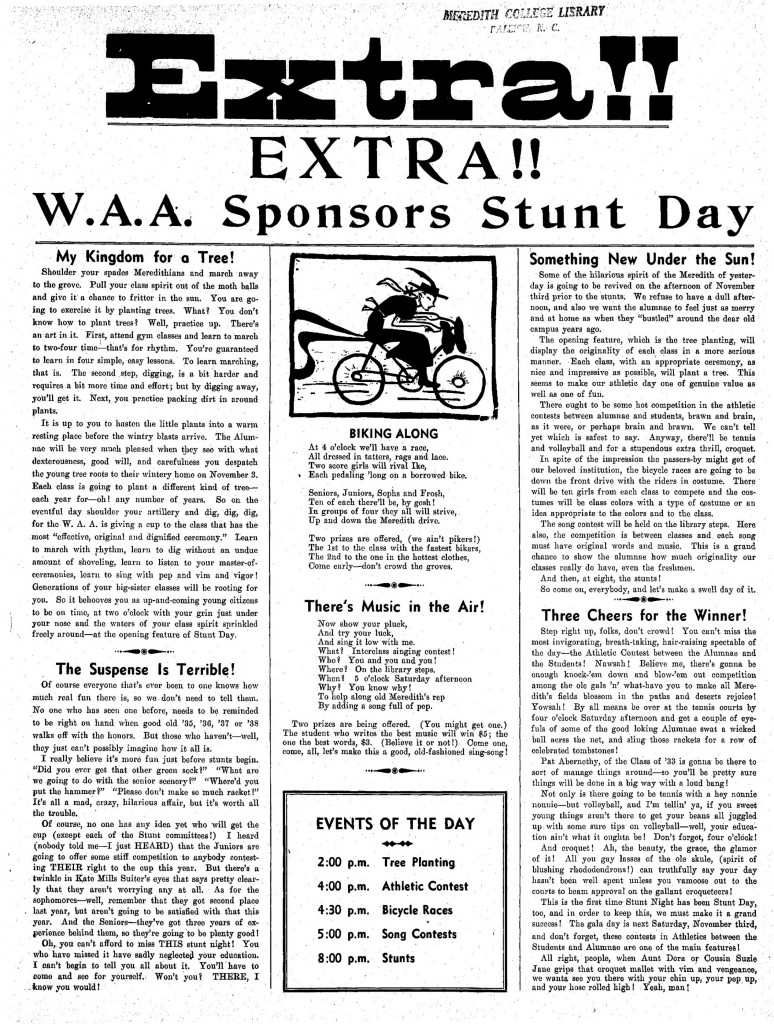
Extra Issue of The Twig, October 27, 1934
We worked with Meredith College to bring these issues, digitized awhile ago by an outside vendor, to DigitalNC.org. Over the next few months, we hope to fill in the missing gaps, to present a more complete run online.
You can view Meredith College yearbooks and newspapers through their contributor page, and find out more about Meredith College’s Archives on their website.
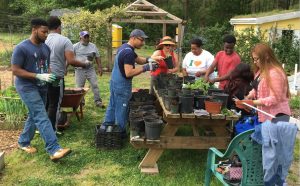
Durham Tech students volunteering and gardening at the Briggs Avenue Community Garden
A new batch of digital materials are now available and online at DigitalNC, courtesy of our partner, Durham Technical Community College. Included in this collection is over a half-dozen editions of College Profiles for Durham Tech, the 2017-2018 copy of their Catalog & Student Handbook, the 2018 Campus Harvest Food Pantry Cookbook created by students, and the 2018 copy of The Final Draft.
Included first in this set is a series of College Profiles for Durham Technical Community College. These profiles are short summaries of the statistics about life on campus and curricula at DTCC. These profiles include enrollment rates, student demographics, rates of completion, the number of programs available to students, numbers of faculty, and more. They even include statistics about the facilities and library. Using these profiles, we can see how much Durham Tech has grown in the past decade. For example, the DTCC library had 5 e-books in July 2009, and by July 2016, they had 193,875!
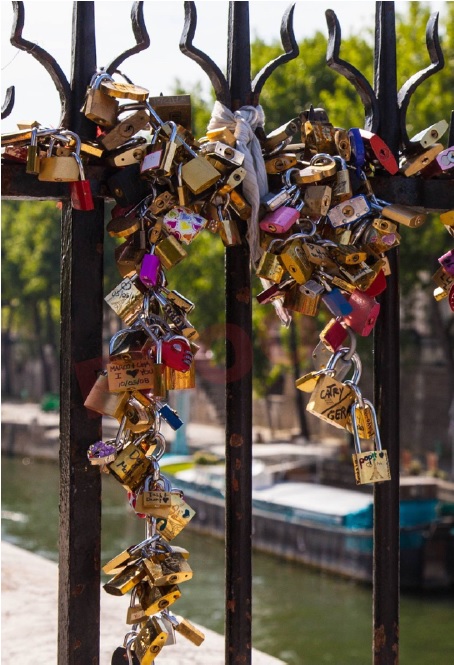
“Paris Love Locks” by Meredith Murray, included in the 2018 edition of Final Draft
Next is a copy of the 2017-2018 DTCC Catalog & Student Handbook. It includes information on admission, tuition rates and enrollment statistics, as well as information on student services, programs of study, and classes that are available.
There is also the 2018 DTCC Campus Harvest Food Pantry Cookbook, a cookbook created and published by the college’s students and members of Campus Harvest Food Pantry. It includes information on food education, several dozens of recipes for breakfast, lunches, dinners, and more, and nutrition facts for every dish. Operated on donations, the cookbook also includes contact information if readers want to support their efforts.
Finally, there is a proof copy of the 2018 edition of The Final Draft, a literary journal created by students and faculty of DTCC, designed to be “A Collection of Creative Works”. It includes short fiction, poetry, photographs, and artwork throughout its pages.
To learn more about Durham Technical Community College, visit their partner page, or take a look at their website. Click here to view other digitized material from DTCC, including other reports, catalogs and student handbooks, and other editions of The Final Draft.
Mascots are a complicated phenomenon. They inspire a spectrum of reactions: ridicule, ambivalence, or fierce loyalty. With thousands of yearbooks online, all of us here at the Digital Heritage Center have probably spent more time looking at yearbooks than anyone else you’re likely to meet. Mascots are a common theme.
I’ve been working on today’s post for quite some time; unable to find a history or comprehensive list of mascots in North Carolina I decided to compile one myself. So here’s a stab at a college mascot overview, drawn from yearbooks and other campus publications. Let me know what I’ve missed or gotten wrong!
Children
In the early 20th century, schools frequently chose children as mascots or sponsors, whether for a sports team or for a particular class. The earliest example we’ve found on DigitalNC is from a 1910 publication by Atlantic Christian College (now Barton College) in Wilson, which shows Elizabeth Settle Caldwell as the Senior Class sponsor.
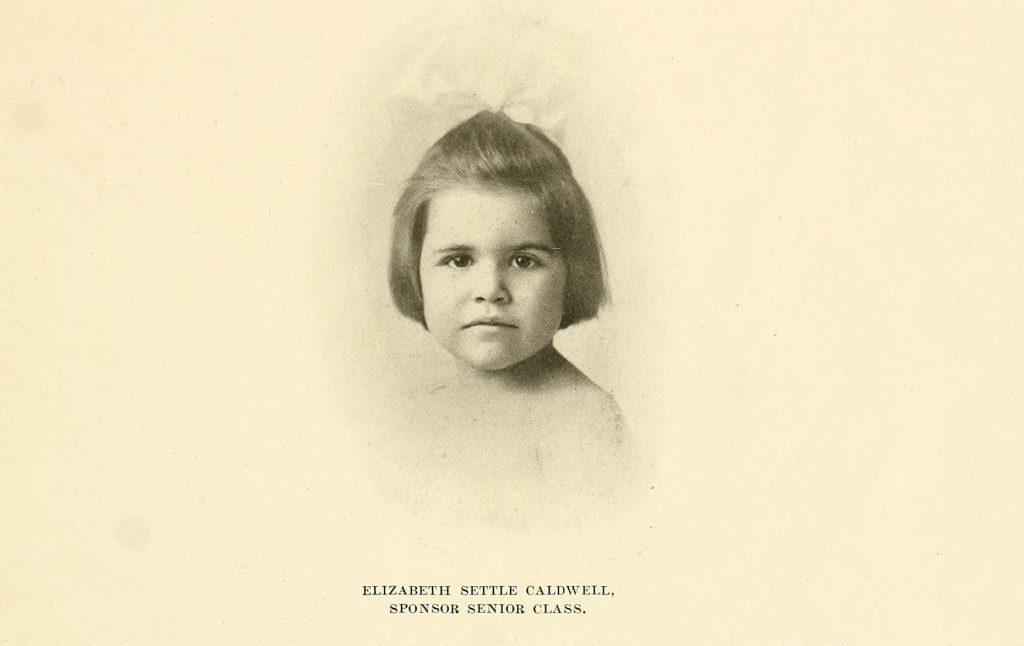
Elizabeth Settle Caldwell, First North Carolina Mascot? From the 1910 Pine Knot yearbook, Atlantic Christian College.
Ms. Caldwell was the daughter of Jesse Cobb Caldwell, the college president. From what we’ve been able to tell, children mascots were frequently younger siblings of students, teachers, or others associated with the school. Students mention that Ms. Caldwell brought “solace to many a lonely, homesick heart” and this may be why children were chosen – to foster a feeling of family and comfort among students. We’ve seen several references to mascots being elected or being chosen through competition, although what this might be we haven’t been able to discover. The trend of choosing children as mascots seems to continue through the 1960s. The latest one we found is Dawn, the Senior Class mascot at Peace College (now William Peace University) in 1966.
Animals
Animal mascots span schools across the state, whether it’s Rameses at UNC-Chapel Hill or WCU’s Catamount. The bulldog and different types of cats win out as most frequently adopted. Pictures of live animal mascots start to appear in yearbooks in the early 1900s, and continue today although much less frequently. For a variety of reasons, including concerns expressed by animal rights activists, schools have shifted away from actual animals to students dressing up like animals, as you’ll see later on in this post.
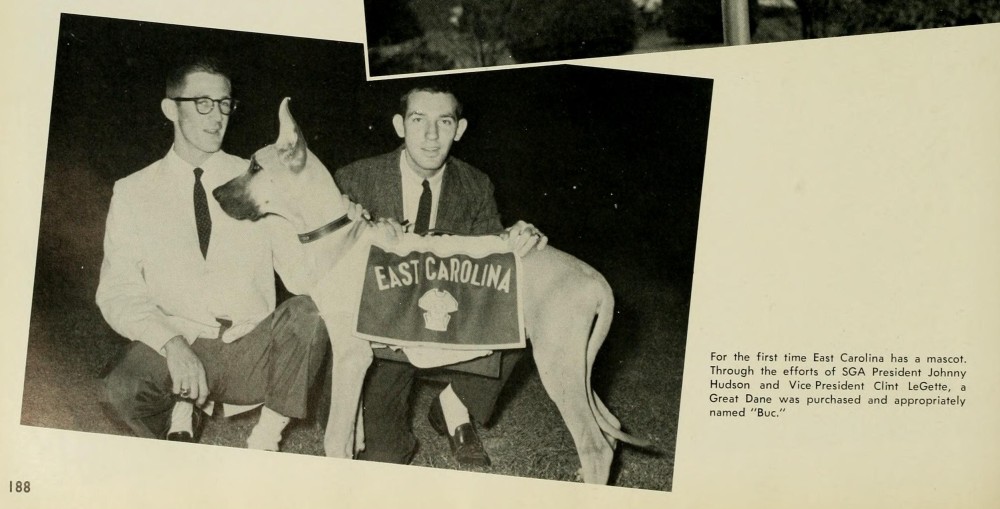
“Buc” is described here as East Carolina University’s first mascot. From the 1959 Buccaneer yearbook.
Characters
While about half of the four-year college mascots in North Carolina are animals, most of the others are characters that are historic, mythical, or extraordinary in nature. From what I’ve seen in NC yearbooks, humans dressing up as the school mascot really got traction in the 1960s. Initially, these costumes weren’t the fuzzy creations we think of today, but rather less complicated ensembles where the mascot’s identity (his or her face and body) was often apparent. Yosef the Mountaineer, beloved icon of Appalachian State University, was created sometime around 1942 and looked like this in the 1960s:
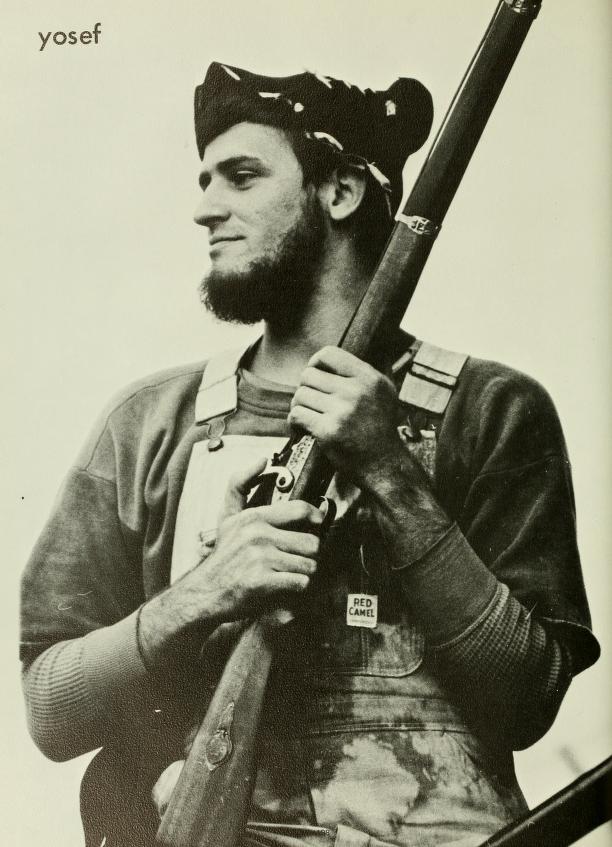
Yosef the Mountaineer, aka James Randle Tedder (we think). From the 1969 Rhododendron yearbook, Appalachian State University.
One of my favorites has to be this picture of Duke Blue Devil, from 1950:
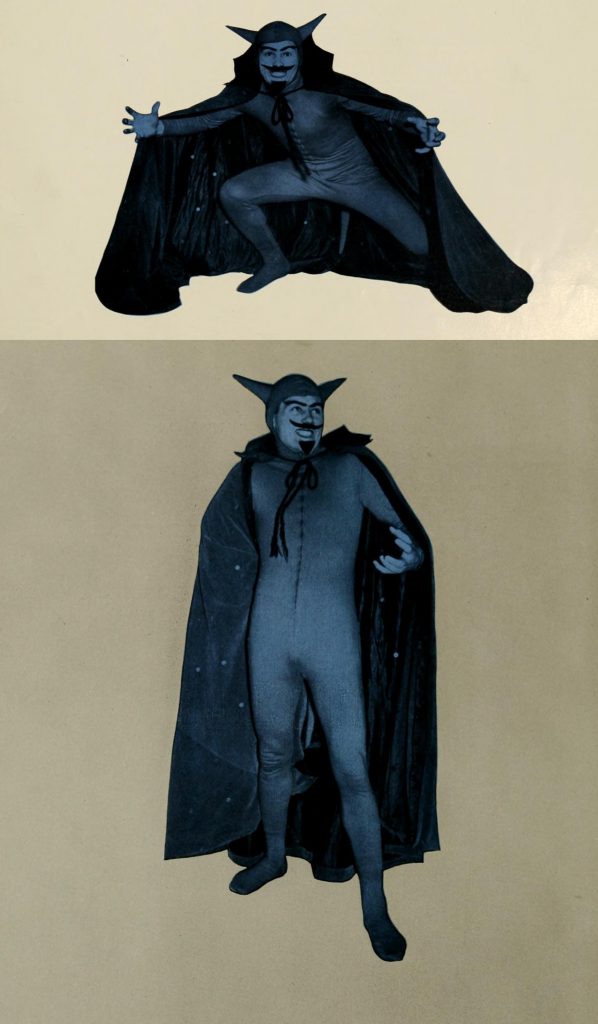
The Blue Devil. From the 1950 Chanticleer yearbook, Duke University.
Perhaps it was too hard to maintain a degree of consistency as students graduated over the years, and mascot anonymity seemed like a better idea. Whatever the reason, you start to see fuzzy, oversized costumes with gigantic headpieces in the late 1970s.
The Big Costumes
Whether animal or character, plush mascots that include a single piece body suit with a large plastic or cloth-covered head is something most Americans can identify with, thanks to professional sports. Colleges in North Carolina really embraced these costumes through the 1980s. Here’s what the UNC-Wilmington Seahawk looked like in 1987:

The Seahawk. From the 1987 Fledgling yearbook, UNC-Wilmington.
Some schools have developed multiple mascots dedicated to different audiences. It seems like the difficulty with these types of costumes is how to pull off a fierce facial expression that doesn’t come off as goofy or too scary for children. I think this picture from Davidson College sums it all up:
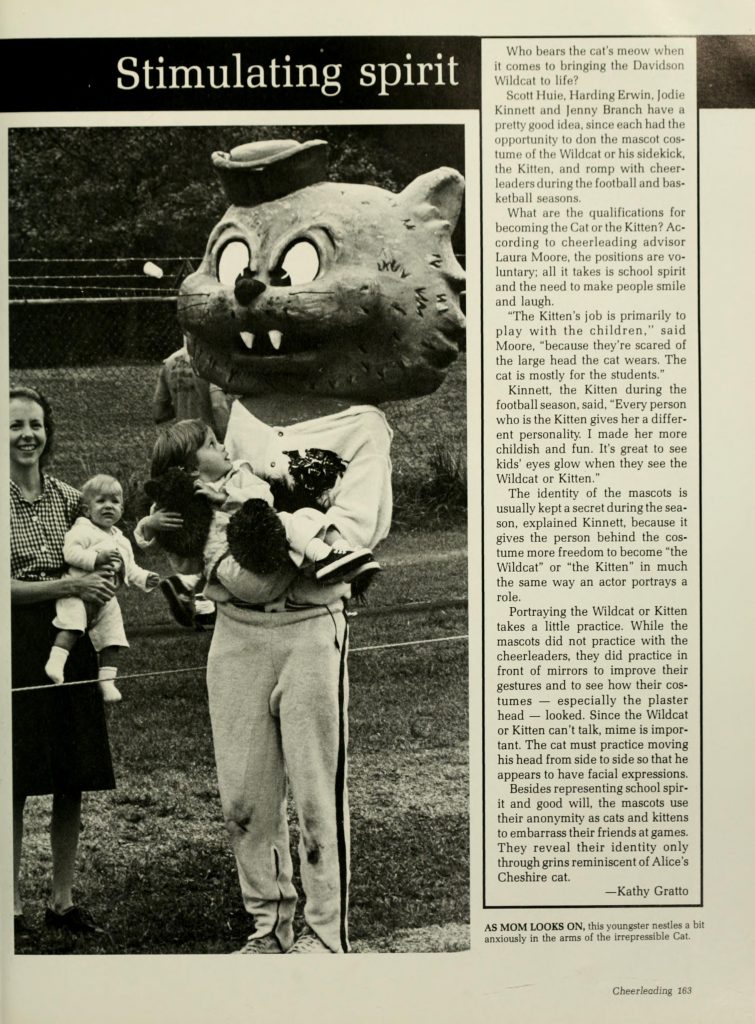
The Davidson Wildcat and … friends. From the 1983 Quips and Cranks yearbook.
I will also take this opportunity to mention a mascot that routinely makes the “wait … what?” list – the Campbell University Fighting Camels:
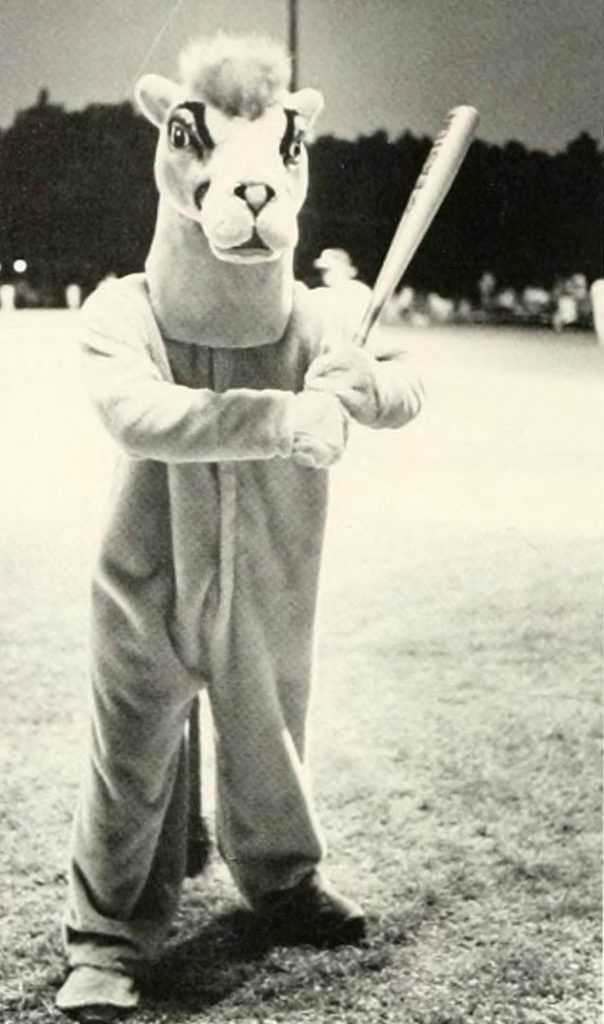
The Campbell Camel. From the 1983 Pine Burr yearbook.
Even the humans and human-like creatures are clothed in oversized costumes these days. Wake Forest University’s Deacon is a dapper chap:
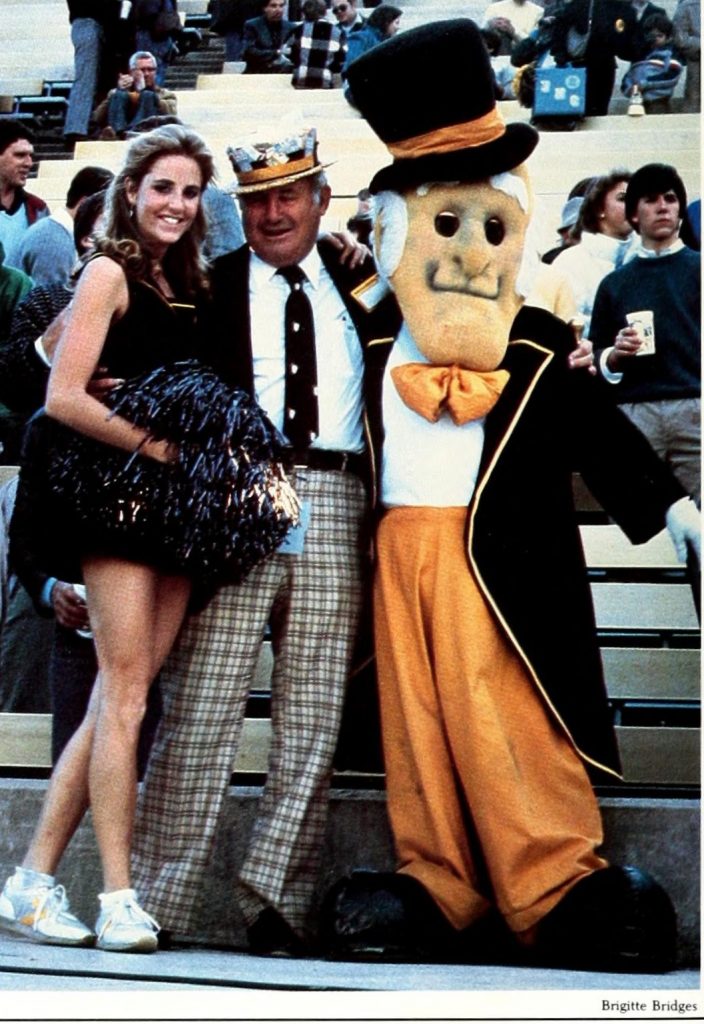
Wake Forest’s Deacon poses with fans. From the 1985 Howler yearbook.
In addition to the Demon Deacons and the Blue Devils, North Carolina boasts a number of other spiritual mascots: North Carolina Wesleyan’s Battling Bishops, Belmont Abbey’s Crusaders, and Guilford College’s Quakers. Meredith College’s teams are known as the Avenging Angels (formerly just the Angels). While Elon University’s mascot is now the Phoenix, before 2000 they were the Fighting Christians:
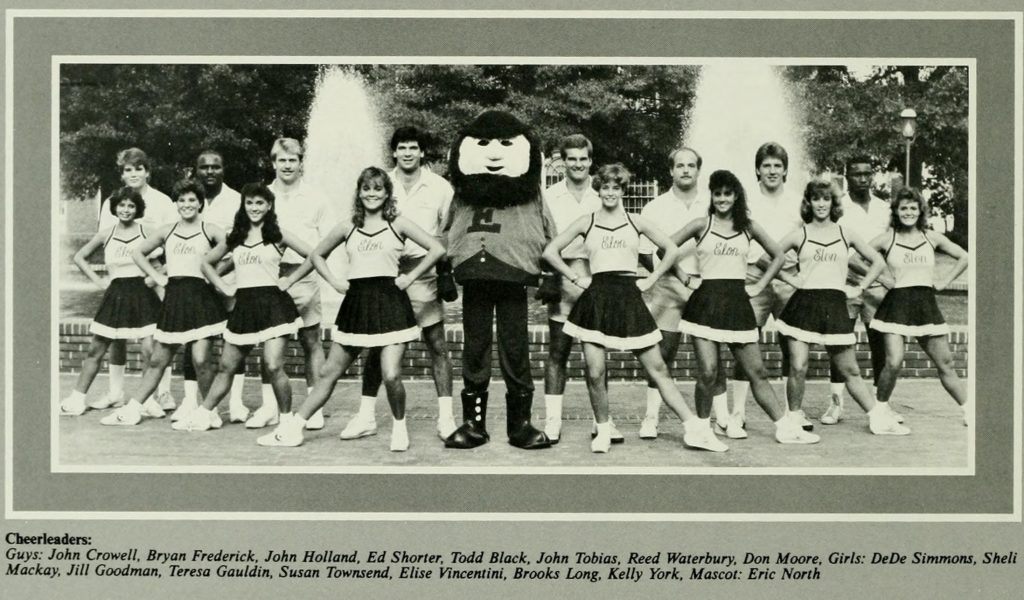
The Elon Fighting Christian mascot with cheerleaders. From the 1986 Phi Psi Cli yearbook.
Two schools break with the animal/human tradition in North Carolina. The Brevard College Tornadoes and the Louisburg College Hurricanes. Weather phenomena mascots are always difficult to pull off. I couldn’t find one for Brevard, but Louisburg, which currently has a bird mascot, had “Louie” up until 2006:
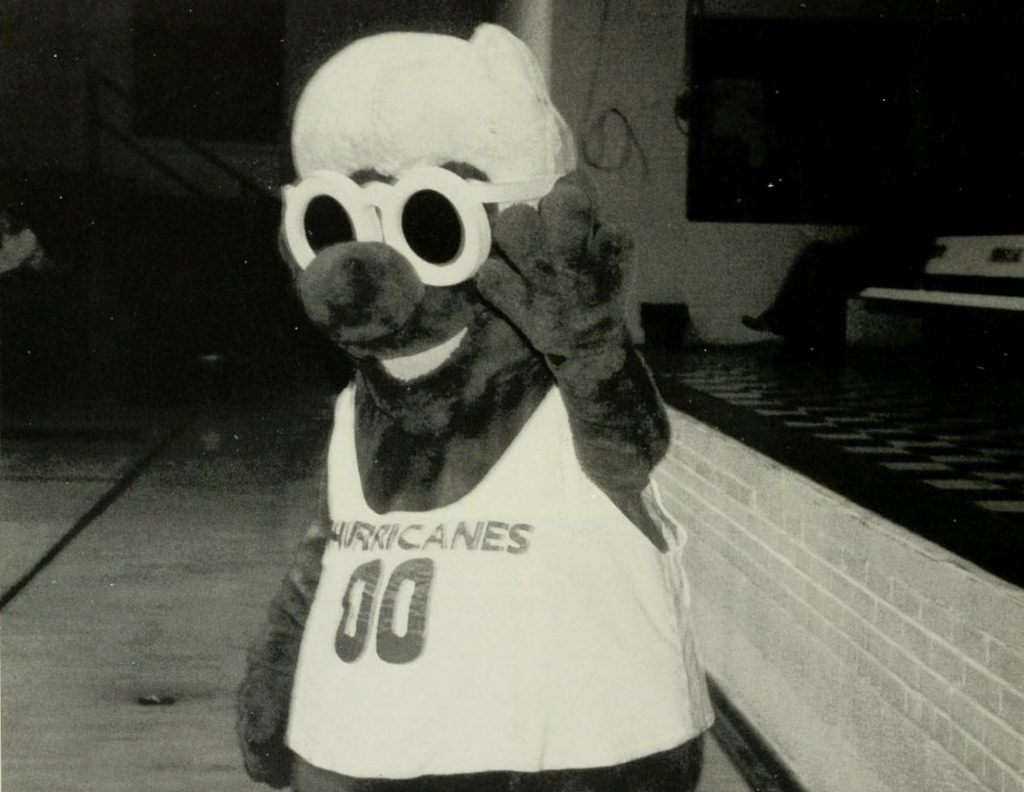
Louie, the former Louisburg College Hurricanes mascot. From the 1996 The Oak yearbook.
Who knows when the next mascot sea change will happen. Below is a list of mascots in North Carolina; let us know if we got anything wrong. Which one is your favorite?
| School |
Mascot |
Notes |
| Appalachian State University |
Yosef the Mountaineer |
First appeared in the yearbook in 1942 |
| Barton College |
Bulldog |
|
| Belmont Abbey College |
Crusader |
|
| Bennett College |
|
Known as the Bennett Belles |
| Brevard College |
Tornado |
|
| Campbell University |
Fighting Camels |
The Hornets in the 1920s-1930s |
| Catawba College |
Catawba Indian |
|
| Chowan University |
Hawks |
The Braves until 2006 |
| Davidson College |
Wildcats |
Also a bulldog (1929) and a bobcat (1939) |
| Duke University |
Blue Devil |
|
| East Carolina University |
Pirates |
Formerly Pee Dee the Pirate |
| Elizabeth City State University |
Vikings |
|
| Elon University |
Phoenix |
The Fightin’ Christians until 2000 |
| Fayetteville State University |
Broncos |
|
| Gardner-Webb University |
Runnin’ Bulldogs |
|
| Greensboro College |
The Pride |
Formerly the Hornets |
| Guilford College |
Quakers |
|
| High Point University |
Panthers |
|
| Johnson C. Smith University |
Golden Bulls |
|
| Lees-McRae College |
Wily the Bobcat |
|
| Lenoir-Rhyne University |
Joe and Josie Bear |
|
| Louisburg College |
Hurricanes |
|
| Mars Hill College |
Mountain Lion |
|
| Meredith College |
Avenging Angels |
Formerly the Angels |
| Methodist University |
Eagles |
|
| Montreat College |
Cavaliers |
|
| Mount Olive College |
Trojans |
|
| North Carolina A&T |
Aggie Dog (Bulldog) |
|
| North Carolina Central University |
Eagles |
|
| North Carolina State University |
Wolfpack |
|
| North Carolina Wesleyan College |
Battling Bishops |
Formerly the Circuit Riders |
| Peace College |
Pacer |
|
| Pfeiffer University |
Falcons |
|
| Queens University of Charlotte |
Rex the Royal |
|
| Saint Augustine’s University |
Mighty Falcons |
|
| Salem College |
Spirits |
|
| Shaw University |
Bears |
|
| St. Andrews University |
Knights |
|
| UNC Asheville |
Bulldog |
|
| UNC Chapel Hill |
Rameses the Ram |
Also known as the Tar Heels |
| UNC Charlotte |
Norm the Niner |
|
| UNC Greensboro |
Spartans |
|
| UNC Pembroke |
Braves |
|
| UNC Wilmington |
Seahawk |
|
| UNC School of the Arts |
Fighting Pickle |
|
| UNC School of Science and Math |
Unicorn |
|
| Wake Forest University |
Demon Deacons |
|
| Warren Wilson College |
Owls |
|
| Western Carolina University |
Catamount |
“Paws” |
| Wingate University |
Bulldog |
|
| Winston-Salem State University |
Ram |
|
The North Carolina Digital Heritage Center has now digitized over 1,000 yearbooks. Fourteen different colleges and universities have participated in the program to date, and many more are scheduled to participate over the next year. The yearbooks on the North Carolina College and University Yearbooks collection range in date from 1890 (UNC-Chapel Hill) to 2009 (Elon University, Campbell University, and Meredith College). Whether you’re researching family history, looking up old sports teams, or reliving your college years, the online yearbook collection is a great place to spend some time.
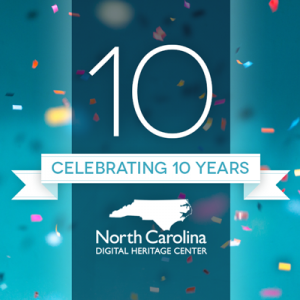 It’s DigitalNC.org’s 10th birthday! Though we had hoped to be in the office celebrating, we’re still taking time to look back at years of hard work and the collaborative spirit that makes the North Carolina Digital Heritage Center (NCDHC) what it is!
It’s DigitalNC.org’s 10th birthday! Though we had hoped to be in the office celebrating, we’re still taking time to look back at years of hard work and the collaborative spirit that makes the North Carolina Digital Heritage Center (NCDHC) what it is!
To date, NCDHC has partnered with 273 libraries, museums, alumni associations, archives, and historic sites in 98 of North Carolina’s 100 counties and we’re growing all the time. Our website currently includes 4.2 million images and files. We share this accomplishment with every institution we’ve worked with. We’d never have gotten to 10 years without staff (permanent, temporary, and student!), our partners, or the network of colleagues all over North Carolina who have encouraged, advised, and supported our work.
As we approached our anniversary, we realized that our website lacked a synopsis of how NCDHC came to be, and our history. So read on for a brief look at how we got started and our major milestones.
Our History
The North Carolina Digital Heritage Center was one outcome of a comprehensive effort by the state’s Department of Cultural Resources (now the Department of Natural and Cultural Resources) to survey and get a broad overview of the status of North Carolina cultural heritage institutions. That effort was entitled NC ECHO (North Carolina Exploring Cultural Heritage Online) and was funded by the Institute of Museum and Library Services (which also supports us – thanks IMLS). A major goal of NC ECHO was a multi-year needs assessment. NC ECHO staff visited hundreds of cultural heritage institutions throughout the state to collect data and interview curators, librarians, volunteers, archivists, and more. Many of our partners still remember their visits!
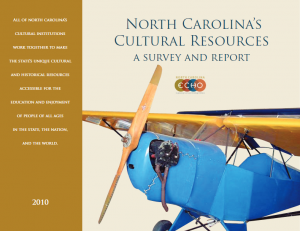 Data collected at these site visits was combined with survey responses to reveal a “state of the state,” summarized in a 2010 report, cover pictured at right. The assessment revealed a lot but, specific to digitization, staff found that nearly three-quarters of the 761 institutions who completed the survey had no digitization experience or capacity. Members of the Department of Cultural Resources (which includes the State Library, State Archives, and multiple museums and historic sites) began brainstorming with other area institutions about a way to help efficiently and effectively provide digitization opportunities. While the NC ECHO project offered digitization grants, workshops, and best practices, an idea emerged of a centralized entity that could assist institutions that didn’t have the capacity to do the work in house. The State Library of North Carolina and UNC-Chapel Hill Libraries joined together to create such an entity: the North Carolina Digital Heritage Center. The Center would be located in Chapel Hill, taking advantage of its central location and the digitization equipment and expertise already available in Wilson Special Collections Library. The State Library would provide funding, guidance, and ongoing promotion and support of the Center’s services.
Data collected at these site visits was combined with survey responses to reveal a “state of the state,” summarized in a 2010 report, cover pictured at right. The assessment revealed a lot but, specific to digitization, staff found that nearly three-quarters of the 761 institutions who completed the survey had no digitization experience or capacity. Members of the Department of Cultural Resources (which includes the State Library, State Archives, and multiple museums and historic sites) began brainstorming with other area institutions about a way to help efficiently and effectively provide digitization opportunities. While the NC ECHO project offered digitization grants, workshops, and best practices, an idea emerged of a centralized entity that could assist institutions that didn’t have the capacity to do the work in house. The State Library of North Carolina and UNC-Chapel Hill Libraries joined together to create such an entity: the North Carolina Digital Heritage Center. The Center would be located in Chapel Hill, taking advantage of its central location and the digitization equipment and expertise already available in Wilson Special Collections Library. The State Library would provide funding, guidance, and ongoing promotion and support of the Center’s services.
At its beginning, the Center’s staff digitized small collections of college yearbooks, needlework samplers, postcards, and photographs and made them available through DigitalNC.org. They went to speak with organizations interested in becoming partners, and began taking projects for digitization. Here’s a list of NCDHC’s earliest partners, who came on board during late 2009 and 2010.
Though we’re not positive of the exact date, we believe DigitalNC.org launched on or near May 12, 2010. Here’s a look at that original site!
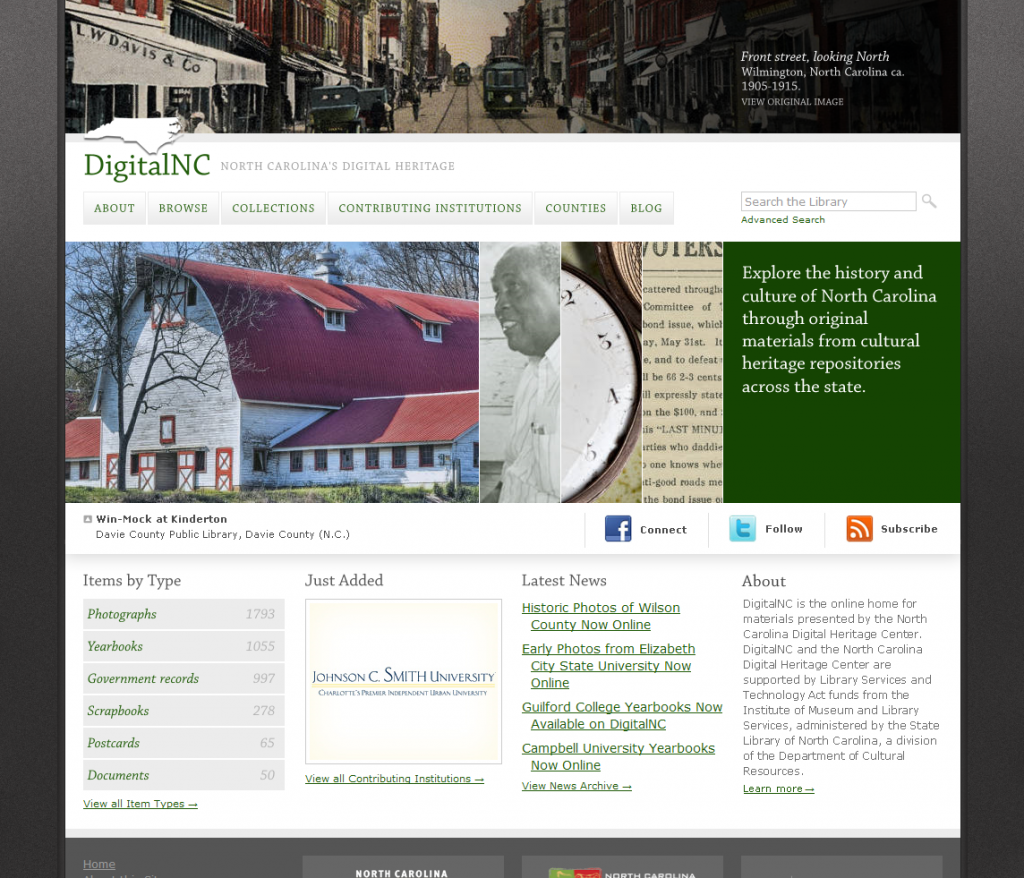
In 2011, word about the Center spread. Staff started responding to demand from partners, incorporating newspaper digitization. In late 2012, also in response to popular demand, the Center began digitizing high school yearbooks. Yearbooks and newspapers are some of the most viewed items on DigitalNC, and they remain a significant portion of our work to this day.
In 2013, NCDHC joined the Digital Public Library of America (DPLA) as North Carolina’s “service hub.” The DPLA collects information from digitized collections all over the nation and provides it together in one searchable interface at dp.la. Because of our participation, users can browse and search for collections from North Carolina alongside items from institutions around the country.
Throughout the years, we’ve tried to expand services to fit our partners’ goals. In 2015, we trialed an audiovisual digitization project that incorporated the first films into DigitalNC. Today, we partner with the Southern Folklife Collection at Wilson Special Collections Library to provide audio digitization on an ongoing basis. In 2016, we added a new partner category – alumni associations – to support more digitization of African American high school yearbooks and memorabilia. The following year, we announced a focus on digitization of items documenting underrepresented communities. We also started going on the road with our scanners! For institutions that don’t have the staff time or resources to travel to Chapel Hill, we offer to come for a day or two and scan on site.
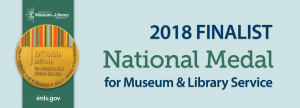 2018 and 2019 saw several major milestones. We were nationally recognized as an Institute of Museum and Library Services National Medal finalist, and we began a major software migration. Both were a tribute to the size and extent of our operation, though in different ways. As we’ve approached our 10th anniversary we’ve focused on working with partners in all 100 of North Carolina’s counties. Whether you’re rural or metropolitan, we believe your history is important and should be shared online.
2018 and 2019 saw several major milestones. We were nationally recognized as an Institute of Museum and Library Services National Medal finalist, and we began a major software migration. Both were a tribute to the size and extent of our operation, though in different ways. As we’ve approached our 10th anniversary we’ve focused on working with partners in all 100 of North Carolina’s counties. Whether you’re rural or metropolitan, we believe your history is important and should be shared online.
One of the ways we’re commemorating this anniversary is to ask our partners and stakeholders how they think we’ve impacted them and their audiences. Join us here on the blog in the second half of 2020 as we share these brief interviews, reflect, and celebrate. Thank you for reading, enjoy the site, and here’s to another 10 years of making North Carolina’s cultural heritage accessible online!
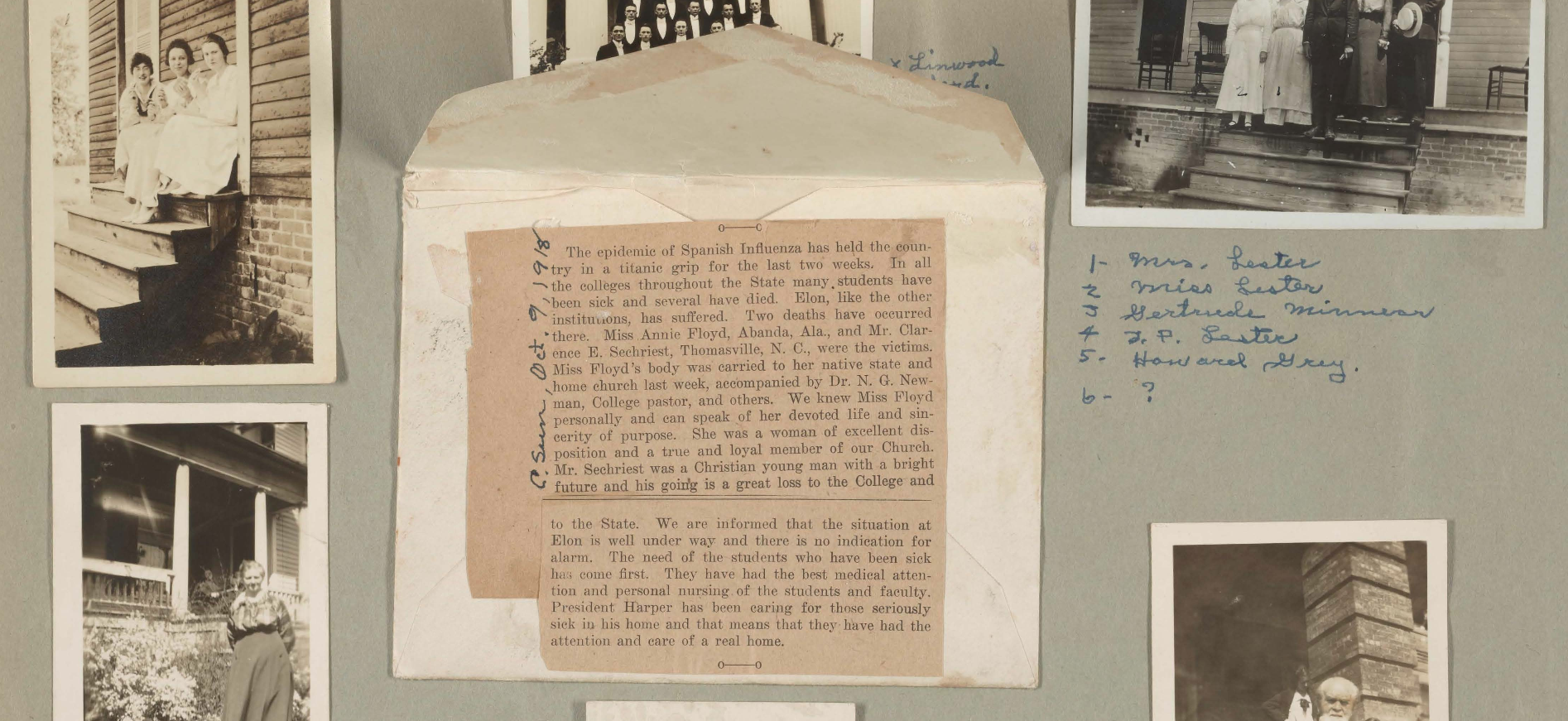
Page 31 of Annie Gordon Floyd’s scrapbook, a student at Elon College during the influenza pandemic of 1918. The newspaper clipping is Annie’s obitual; she died of influenza.
Here at the University of North Carolina, Chapel Hill, as well as across the globe, graduating students are leaving their school years behind without the normal pomp and circumstance. After years of late-night study sessions and racing to beat the assignment submission clock on Sakai, who would have thought that a pandemic would get between them and their walk across the commencement stage? While achieving a degree is a reason to celebrate regardless of location, perhaps 2020 graduates and all self-isolating students can relate to the experiences of an older group of students- those affected by the 1918 influenza pandemic.
Cutting through the spring of 1918 to 1919, the influenza pandemic was a worldwide health issue not unlike today. In North Carolina, industries were halted and quarantine was enacted (and extended). Universities, too, established their own versions of quarantine. Thanks to the institutions we work with here at DigitalNC, we have digitized yearbooks, scrapbooks, and college publications that offer a glimpse into the thoughts of students during this equally tumultuous time in history.
Quarantine was enacted in fits and spurts on campuses across North Carolina between 1918 and 1920. As is evident by yearbook social calendars, measures varied across universities. One campus quarantined through most of November 1918 while others were still starting up quarantine periods in February and March 1920.
Campus clubs have a dedicated slice of yearbook real estate during this time and the influenza directly impacted their activities. As the pandemic coincided with the last days of World War I, Student Army Training Corps (S.A.T.C.) were a part of many universities. The S.A.T.C. at Meredith College recounts their quarantine movements that saved faculty and students from “nervous prostration”. UNC’s S.A.T.C. found the flu less inspiring. Other students responded by creating clubs. At Queens College, Quarantine Club, seen left, first began in 1918 with the aim “to extend the quarantine”. Later, in 1920, the club edited their name to simply “Flu” Club, as seen below.
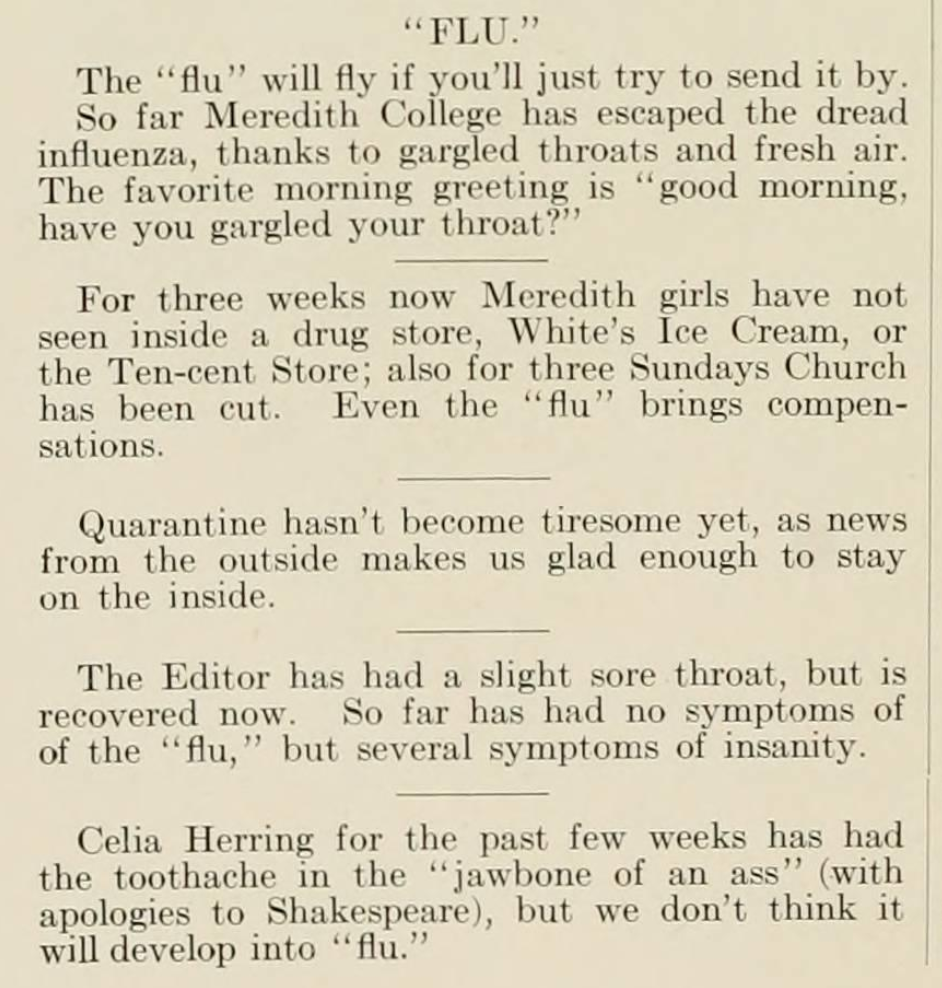
“Flu” section of the Meredith News and Distributor by French Haynes, Oak Leaves, 1919.
Students also utilized their yearbooks to creatively vent frustrations. In 1918, Atlantic Christian College students were under quarantine from February 6th to the 27th. Student Bonita Wolff penned several poems for The Radiant, including “Quarantined”, shown above. Another funny quarantine themed poem can be found in the advertisement section of the 1920 edition of St. Mary’s Muse.
Meredith College graduate French Haynes embedded influenza jokes throughout the satirical Meredith News and Distributor, shown to the right. And in 1920, Elizabeth Gaskins spotted a deficiency in her local health care system, due in part to the influenza, and argued for the creation of a local hospital in the Greenville High School yearbook The Tau.
If anything, these yearbooks serve as a reminder that this moment is not permanent. Comparing pandemics may be apples to oranges, especially when one student called quarantine “an awful bore” in a college that was only under quarantine for a month at a time, but Mary Reed Buchanan, member of the 1919 graduating class of the women’s college Peace Institute, offers some perspective in the senior class history:
With the warm spring came the renewal of all our former pleasures. There were parties galore, and girls, will you ever forget those State College receptions? And do you remember those exciting basketball games and the serenades afterwards? The feeling of being well again and out of quarantine brightened every heart and lightened every burden.
Even though we may not be attending basketball games anytime soon, we can look to those who have gone through a pandemic before and know that life, including student life, continues on. And for those who are graduating, Mary Reed Buchanan, noted suffragette, has final words:
For a look at all of DigitalNCs college and high school yearbooks, click here. Or, to view all memorabilia including scrapbooks, click here.

In today’s blog post I offer a break from the current election year with a trip back to the 1968 presidential election. Looking at the political landscape of 1968 is like looking at an earlier but familiar view of the same neighborhood we’re in now. It’s issues resonate today: striving for social and racial equality, debates over America’s place on the world stage. The late 60s were boiling with the turmoil of the Civil Rights Era and the Vietnam War. 1968 alone saw the assassination of Dr. Martin Luther King, Jr. in early April and presidential candidate Robert F. Kennedy in June.
In April 1968, Time magazine held a mock presidential primary at colleges and universities to take the temperature of young Americans during that election year. Dubbed “CHOICE 68,” the event was covered in many of the student newspapers that can be found on DigitalNC, and I wanted to see what this nation-wide event looked like here in North Carolina.
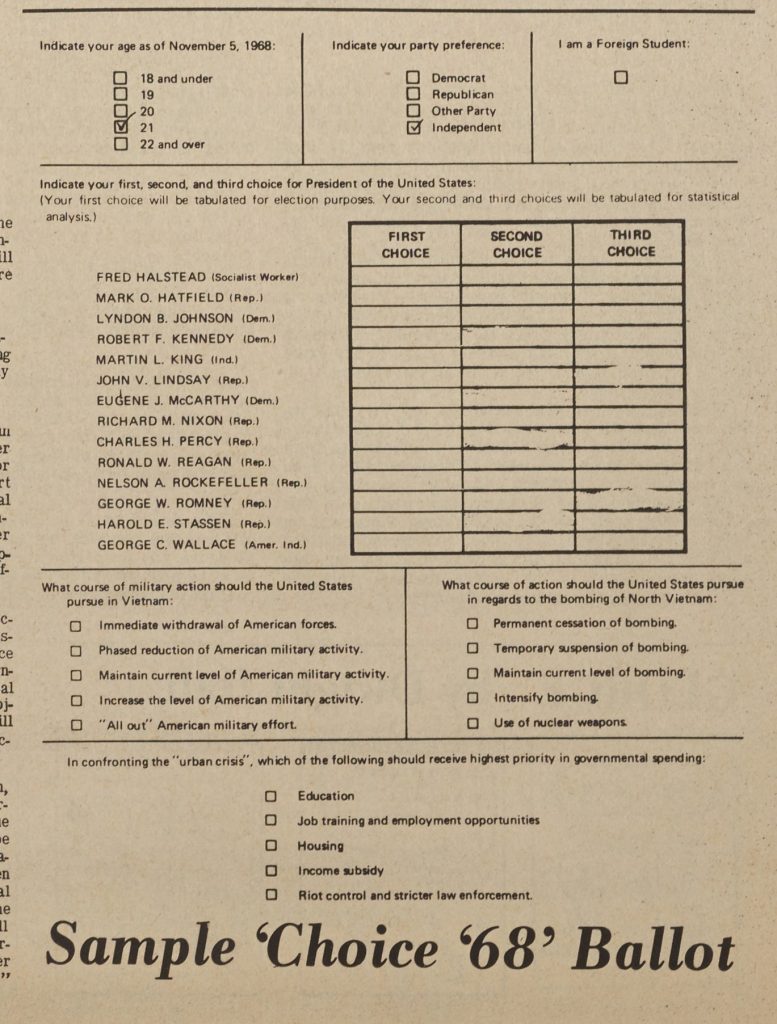
Sample Choice 68 Ballot, printed in Asheville-Biltmore College (now UNCA) newspaper The Ridgerunner, March 1, 1968.
Every American college and university was asked to participate in CHOICE 68. The event was governed by a group of eleven students representing a variety of campuses around the country. Campus groups were in charge of publicizing the event with their peers, under the direction of a campus coordinator. Each ballot (an early draft is shown at right) asked students to rank their top three choices for president and also asked for them to weigh in on Vietnam and the “urban crisis,” the latter of which referred to pervasive concern over poverty, crime, and general unrest in high population urban environments. Write-in candidates were also allowed. Votes from all campuses were tabulated by a UNIVAC computer in Washington, D.C. and the results were supposedly announced on television, with each school’s individual totals being returned during the first week of May.
Before the vote, student newspapers urged their readers to rally against apathy, to prove that young voters could impact the national arena. One Brevard College editorial called on moderates to vote, expressing frustration that liberal and conservative activists had been “hoarding the headlines.” An accompanying editorial talked about the conservatives still being committed to rooting out Communism, revealing lingering echoes of McCarthyism from the late 50s. It predicted a 1968 election win for then Governor of California, Ronald Reagan.
Campuses with active student government associations and/or political groups tended to have more events and publicity associated with CHOICE 68. North Carolina Wesleyan College’s student body listened to speeches in support of Senator Eugene McCarthy (D), former Vice President Richard Nixon (R), and current Vice President Hubert Humphrey (D), three of the most prominent contenders in early 1968. Voting booths, borrowed from the City of Rocky Mount, housed students punching out chads of computer cards to cast their votes.
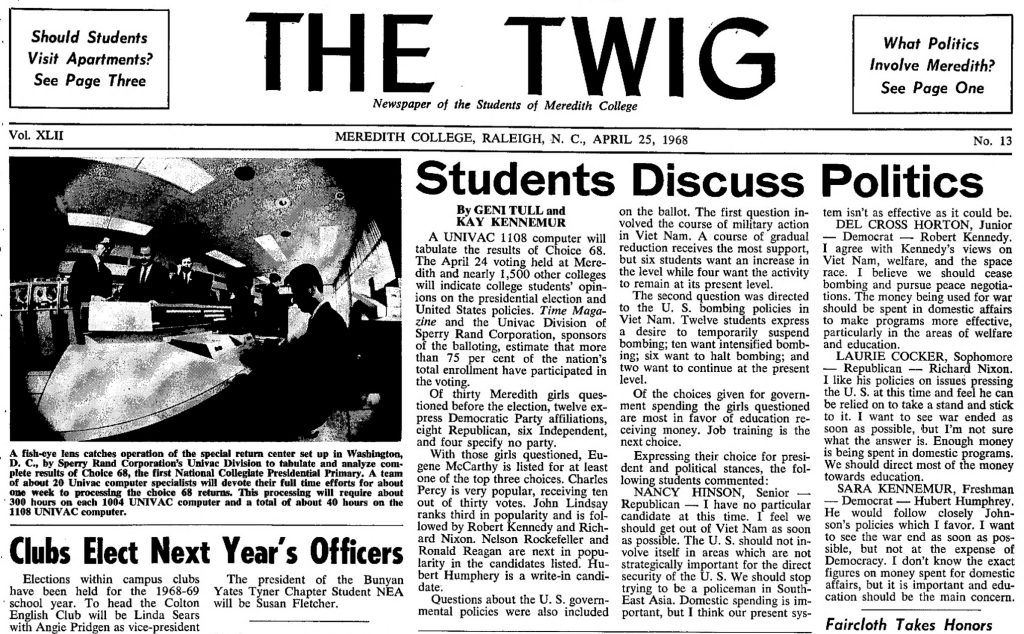
Headline from the April 25, 1968 issue of The Twig, Meredith College.
Some schools had hundreds of participants, with 500 Elon students voting in the mock election. Others had fewer; thirty students were questioned at Meredith College. The Twig quoted opinions from four of those 30 (two Republicans and two Democrats) in the issue seen at right.
Salem College appears to have been one of the most enthusiastic participants, with articles about CHOICE 68 found in issues spanning January through May and a voter turnout of 73% of the eligible student body. The February 23 issue of The Salemite talked about how President Lyndon Johnson endorsed the national mock election despite the fact that “student dissent over the past year ha[d] been directed primarily against White House policies.” The April 12 issue asserted that “massive student participation in CHOICE 68 can and will affect the course of American politics in 1968.”
Almost all articles about the vote mentioned the UNIVAC computation of results, which was seen as heralding a new era in which computers could make generating results faster and more secure. The Meredith College Twig published a photo of the computer tabulating results in its April 25 issue (shown above). Dr. Hammer of UNIVAC posited a time when “a huge data bank may contain ‘voice prints’ of eligible voters” to authenticate those phoning in their votes (“A Letter from the Publisher,” Time, May 10, 1968, page 21).
Of the North Carolina schools* whose CHOICE 68 results I could locate, McCarthy came out on top for all except North Carolina State University, where Nixon prevailed and McCarthy came in second. Nixon was the second choice for 7 schools, and Nelson Rockefeller (R) carried second choice at the remaining 3.
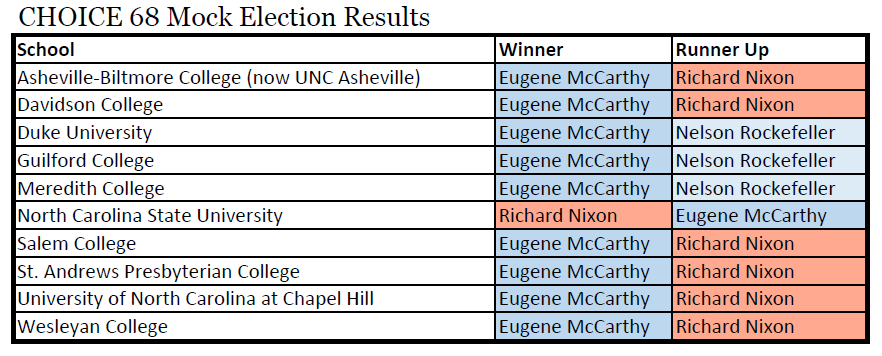
The national CHOICE 68 vote also saw McCarthy in the lead with 286,000 out of 1.7 million votes from 1,450 campuses. Robert Kennedy (D) and Nixon followed behind McCarthy. Students voted to reduce the United States military presence in Vietnam, and saw education as the biggest key to solving the “urban crisis.”
Though he won the CHOICE 68 vote and continued to be bolstered by student support through the primaries, McCarthy was beaten by Humphrey to gain the official Democratic nomination. The November election was won by Nixon, however the CHOICE 68 voters’ preference for a Democratic candidate was somewhat predictive: Humphrey prevailed with voters under 30 in the general election.
As far as I can tell, no nationwide poll quite like CHOICE 68 has been held since, though speculation over how college-aged Americans will vote certainly hasn’t changed. If you’re interested in other historical election news and opinion as reported by student newspapers, visit the North Carolina Newspapers collection.
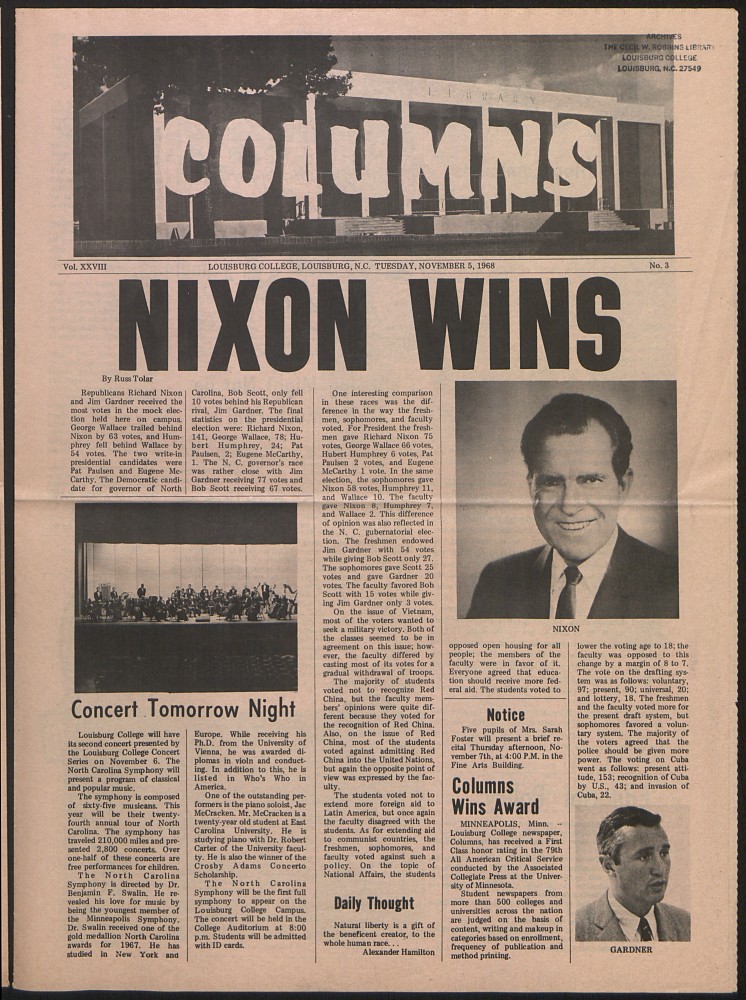
November 5, 1968 issue of the Louisburg College Columns student newspaper. Students picked Nixon in a straw poll held close to the general election.
*It appears that the following schools also participated in CHOICE 68 based on mentions in newspapers and yearbooks, but no results were found: Appalachian State University, High Point College, Lees-McRae College, Lenoir-Rhyne College, Queens College, and University of North Carolina at Greensboro.
